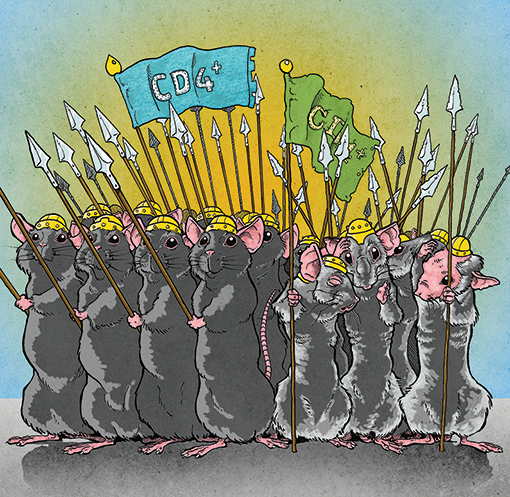
A team of researchers from across Cambridge has shed light on a long-standing debate about why the immune system weakens with age. Their findings, published today in Science, show that immune cells in older tissues lack coordination and exhibit much more variability in gene expression (activity) compared with their younger counterparts.
A team of researchers from across Cambridge has shed light on a long-standing debate about why the immune system weakens with age. Their findings, published today in Science, show that immune cells in older tissues lack coordination and exhibit much more variability in gene expression (activity) compared with their younger counterparts.
As we age, we see a progressive decline of function occur throughout the body, but until now it has not been clear why this decline occurs and why it happens at different rates for different parts of the body. To understand this process, scientists must unpick all of the mechanisms of ageing at the molecular level, for every tissue.
The immune system is like a symphony orchestra, with many different types and subtypes of cells working together to fight infections. But as the immune system ages, its response to infection weakens for reasons that are not yet clear. One long-standing debate amongst scientists concerns two central hypotheses: either the functional degradation is caused by a loss of cellular performance, or it is down to a loss of coordination among cells.
To resolve the debate, scientists at the University of Cambridge, the European Bioinformatics Institute (EMBL-EBI) and the Wellcome Trust Sanger Institute studied many different cell types, analysing ‘average’ gene expression profiles. To do so, they employed high-resolution single-cell sequencing technology to create new insights into how cell-to-cell variability is linked with ageing. The researchers sequenced the RNA of naïve and memory CD4+ T cells in young and old mice, in both stimulated and unstimulated states.
Their findings clearly showed that loss of coordination is a key component of the impaired immune performance caused by T cell ageing.
“You could think of DNA sequencing as a fruit smoothie,” explains Dr John Marioni, Group Leader at EMBL-EBI and at the University of Cambridge’s Cancer Research UK Cambridge Institute (CRUK-CI). “Traditional sequencing technology is a bit like taking a sip of the smoothie, then trying to guess what the ingredients are. Single-cell genomics now lets us study the ingredients individually, so we get direct insight into the constituent parts. Extrapolating, this means that single-cell sequencing allows researchers to individually look at thousands of genes at any given time.”
Dr Duncan Odom, Group Leader at the CRUK-CI and associate faculty at the Wellcome Trust Sanger Institute, shares a further analogy to explain how immune cells fight infection. “Imagine the immune system as a ‘cell army’, ready to protect the body from infection. Our research revealed that this army is well coordinated in young animals, with all the cells working together and operating like a Greek phalanx to block the infection.”

Image: Spencer Phillips, The European Bioinformatics Institute
The researchers say this tight coordination makes the immune system stronger, and allows it to fight infection more effectively. The team’s study shows that as the animal gets older, cell coordination breaks down.
“Although individual cells might still be strong, the lack of coordination between them makes their collective effectiveness lower,” Odom adds.
Previous studies have shown that in young animals, immunological activation results in tightly regulated gene expression. This study further reveals that activation results in a decrease in cell-to-cell variability. Ageing increased the heterogeneity of gene expression in populations of two mice species, as well as in different types of immune cells. This suggests that increased cell-to-cell transcriptional variability may be a hallmark of ageing across most mammalian tissues
“There is a great deal of interest in how biological ageing happens, but not much is known about molecular ageing,” says Dr Celia Pilar Martinez-Jimenez, experimental lead from the CRUK-CI. “This research initiative explored a new facet of cell response to disease, while also tackling questions related to ageing.”
Nils Eling, computational lead of the project and PhD student at EMBL-EBI and CRUK-CI adds: “The advantage of analysing gene expression from single cells is to detect how cell populations synchronise their response. It is interesting to see that ageing strongly distorts this response – a phenomenon which could not be observed before.”
The interdisciplinary study paves the way for a more in-depth exploration of the mechanisms by which different types of cells age. It also illustrates the potential of single-cell sequencing to enable a richer understanding of cell development and activity.
Reference
Martinez-Jimenez, C.P., Eling, N et al Ageing increases cell-to-cell transcriptional variability upon immune stimulation. Science; 30 Mar 2017; DOI: 10.1126/science.aah4115
Adapted from a press release from EMBL-EBI

The text in this work is licensed under a Creative Commons Attribution 4.0 International License. For image use please see separate credits above.
